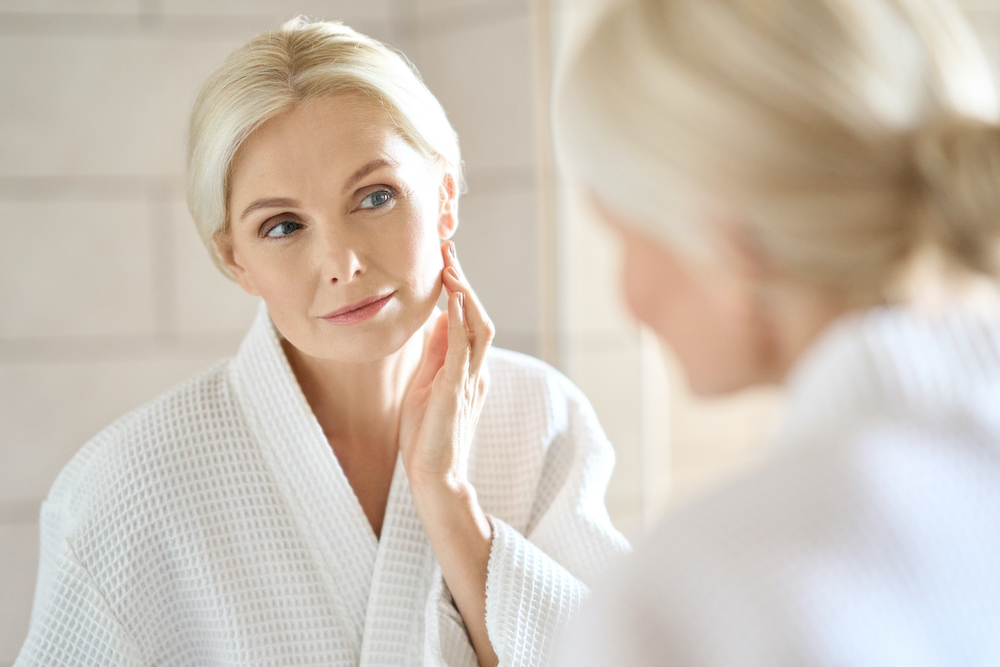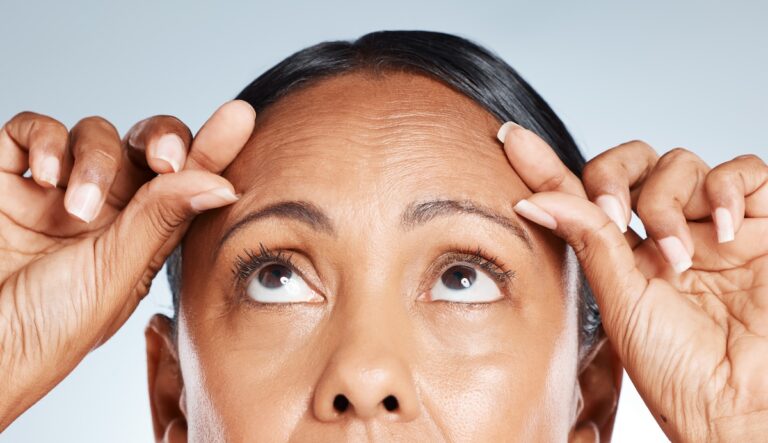What is rosacea?
Rosacea is a chronic condition which does not have a cure. It is, however, treatable. This condition most commonly affects skin primarily on the face. In rare cases, rosacea can occur beyond the face to the neck, chest, scalp, or ear. Rosacea can technically appear on any skin area.
There are multiple ways one could develop rosacea. It is not contagious, though. Those who have it often experience times of breakout in which the skin becomes red and irritated. At other times, it goes into somewhat of a recession and is less apparent. Signs of rosacea are usually always apparent to some degree. Read on to learn what causes rosacea, avoiding downtime, and how long you can expect results to last from rosacea treatment in Wayzata.
What are the signs of rosacea?
Rosacea can present itself in a few different ways. We characterize it as reddening of the facial skin. Blood vessels become visible and skin can become bumpy, with the possibility of some of those bumps becoming pus-filled.
A rosacea outbreak can last for several weeks, and sometimes for months on end before it subsides. Often, this condition’s appearance is similar to acne, skin ruddiness, or several other skin conditions.
The National Rosacea Society, through a consensus committee, along with a review panel of 28 medical experts worldwide agree a diagnosis should include either 1 diagnostic sign, or 2 of the major signs to be a legitimate diagnosis of rosacea. There are 2 diagnostic signs, 4 majors signs, and 3 secondary signs.
Rosacea diagnostic signs
There are 2 symptoms of rosacea that are defined as diagnostic. The first being a persistent redness in the face. This can look like a sunburn or a flushing of the face that doesn’t go away for long periods of time, if at all.
The second sign that you may want to seek a rosacea treatment in Wayzata is what we describe as a thickening of the skin. It isn’t as common, but this thickening often affects the nose specifically. If left untreated, this can cause problems in nasal airflow and could cause facial disfigurement if left unchecked.
Major characteristics of rosacea
Constant blushing
One of the most common, and often, earliest occurring symptoms of rosacea is frequent blushing or flushing of the skin. Patients also report a feeling of warmth or burning of the skin. If you are frequently experiencing skin flushing, this may be an early sign of rosacea.
Blood Vessels showing in skin
A common, but major sign that leads sufferers to seek a rosacea treatment near Woodland is visible blood vessels that become apparent in the affected skin. Telangiectasia (pronounced “tell-ANN-jeck-TAY-zha”) is the clinical term for the appearance of these blood vessels. This most frequently happens in areas central to the face, such as the bridge of the nose or the cheeks.
Red bumps that may be pus-filled
Patients often develop red bumps in the area affected by the rosacea. These bumps are sometimes a mix of solid red bumps and pus-filled bumps that often have a very similar appearance to acne. These bumps may or may not cause a stinging or burning sensation in the affected area.
Secondary symptoms
Dry skin
The area of skin that is mainly affected often feels dry. Some patients experience skin that looks scaly, but is actually oily to the touch.
Painful sensations
Patients often experience sensations of stinging and burning in the affected area of skin. This frequently leads to itchiness in the area or the skin feeling tight.
Swelling
Swelling is a common symptom that can appear without affecting the surrounding skin. Skin becomes raised in red patches.
What causes rosacea?
We see a lot of patients seeking rosacea treatment near Deephaven. What causes rosacea, though? Science still hasn’t narrowed that down to a specific cause yet. However, research has produced several growing theories in recent years. The National Rosacea Society has put consistent effort into better understanding rosacea. With their continued studies of rosacea, more is being learned about the disease process, which is leading to advancements in treatment and possible prevention.
Research has led to discovery of links between rosacea and body systems, physiological changes, genetics, as well as microscopic organisms.
Innate immune system
Scientists have found correlations between rosacea and the innate immune system, the body’s frontline defense from infections. This system can cause inflammation when actively defending the body. This is a good thing when it functions properly. With rosacea, there appears to be a constant overreaction in the system. Studies have shown that individuals with rosacea often have an elevated innate immune system.
Neurovascular system
As learning continues about rosacea, links are being found that point to the body’s neurovascular system, which among other things regulates blood supply to the brain. Something closely linked to this system is the vascular system. The vascular or circulatory system handles the transportation of blood and lymphs through the body. These 2 systems cause flushing and inflammation in the body, which are typical symptoms of rosacea.
Vascular changes
Studies also find that overexposure to UV radiation from sunlight can cause vascular endothelial growth factor (VEGF) This growth has links to development of visible blood vessels, another common symptom of rosacea. This effect is more susceptible for those with fair-skin.
Genetic predisposition
Much like the higher probability of fair-skinned people to have vascular changes, there are certain genetic factors that can make one more susceptible to suffering from rosacea. Studies have also been finding that twin siblings have a higher rate of rosacea when compared to the whole of society. Other researchers have found evidence that there are genetic variants in those with rosacea. They also associated these variants with autoimmune disease. The hope is that specific genome coding will be identifiable, so they can spot rosacea early with a simple blood test. With early detection, the patient could take preventative measures.
Demodex mites
Microorganisms are a normal part of the human body. When properly balanced, there is usually a symbiotic relationship. Microscopic demodex mites are a part of every human body. However, researchers find that those with rosacea have elevated levels of these mites. Further research is being conducted, but an above average demodex mite presence may contribute to an increased level of bacteria associated with the mites. This excess bacteria may cause a defensive response in the body, which leads to inflammation.
What factors increase the risk of developing rosacea?
While anyone might develop rosacea, there appear to be a few factors that increase the probability of contracting rosacea.
- Females are more likely than males to develop rosacea.
- Those who are fair-skinned and burn easily in the sun.
- Those with a family history of rosacea.
- Smoking.
- Those over the age of 30.
What laser treatment works best for rosacea in Wayzata?
ClearSilk
ClearSilk is a non-invasive rosacea treatment in Wayzata that we use regularly to treat all skin types suffering from rosacea. ClearSilk is a gentle laser treatment that targets redness in the skin. The treatment can improve many instances of discolored skin, red, or otherwise. Patients often see improvement in their conditions after 1 treatment. Most see the peak of improvement or elimination after an average of 6 sessions. We usually recommend getting these treatment sessions about 6-8 weeks apart.
Our patients typically find this treatment to be one of the most comfortable when compared to other laser treatments. One of their favorite benefits is that ClearSilk doesn’t require downtime or extra precautions when it comes to sunlight UV exposure. Appointments for treatment don’t take long, typically about 30 minutes, making it easy to slide in a busy schedule. Many refer to ClearSilk laser treatment as the “lunch-time laser”.
ClearSilk can also help with other skin concerns such as,
- Skin laxity
- Fine lines and wrinkles
- Pigmented lesions
- Decreased luminosity
- Scarring from acne
Learn more about ClearSilk and laser treatments from Dr. Josh Martini ↓
Frequently Asked Questions | Rosacea Treatment in Wayzata
How long does a ClearSilk laser treatment take to perform?
This can vary from patient to patient depending how large of an area is being treated. On average, a treatment session is only about 30 minutes long.
What is ClearSilk best for?
ClearSilk can help to reduce or eliminate the overall appearance of blushing and flushing (redness), which is a common symptom of rosacea. This treatment can also provide some tightening and plumping of the skin. Repeated use of this treatment can dramatically improve the overall appearance of the treated skin.
Is a ClearSilk treatment painful?
Some patients report very minor discomfort but it is short-lived. We don’t require anesthetics as they aren’t necessary.
Book a laser rosacea treatment in Wayzata at Vively Body Science!
Our ClearSkin laser facial for rosacea treatment in Wayzata has proven to be a great option for many of our patients. We at Vively love providing a gentle treatment that doesn’t require downtime. Get started on the path to clearer skin today!
Vively Body Science is owned by physicians with over 40 years of experience combined. Our expert staff is well-trained with experience bringing out the best in our patient’s skin.
Our patients come to us from all over Minnesota’s Twin Cities and western suburb areas, including: Deephaven, Golden Valley, Long Lake, Medina, Minnetonka, Minnetonka Beach, Minnetrista, Mound, Orono, Plymouth, St. Louis Park, Wayzata, and Woodland.
Schedule your complimentary skin consultation with our laser facial specialists to learn how we can help your skin look its best.
Find us at 1133 Wayzata Blvd East. Wayzata, Minnesota.
Call us at (952) 388-3113 or schedule an appointment online today.




